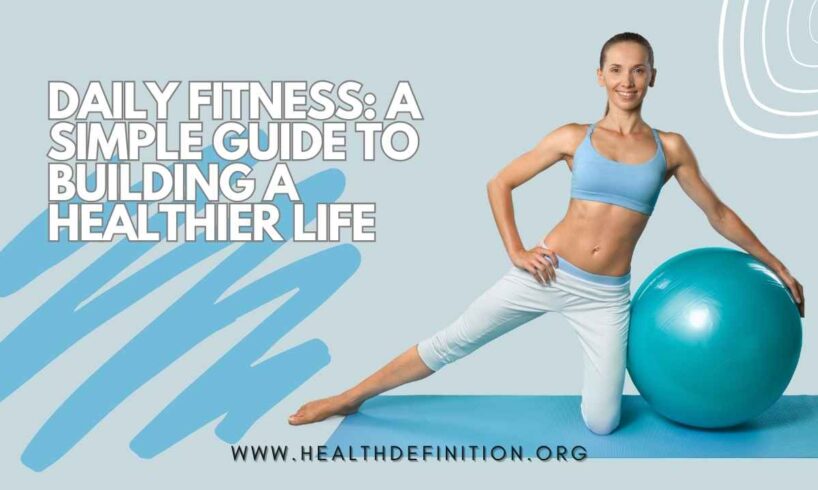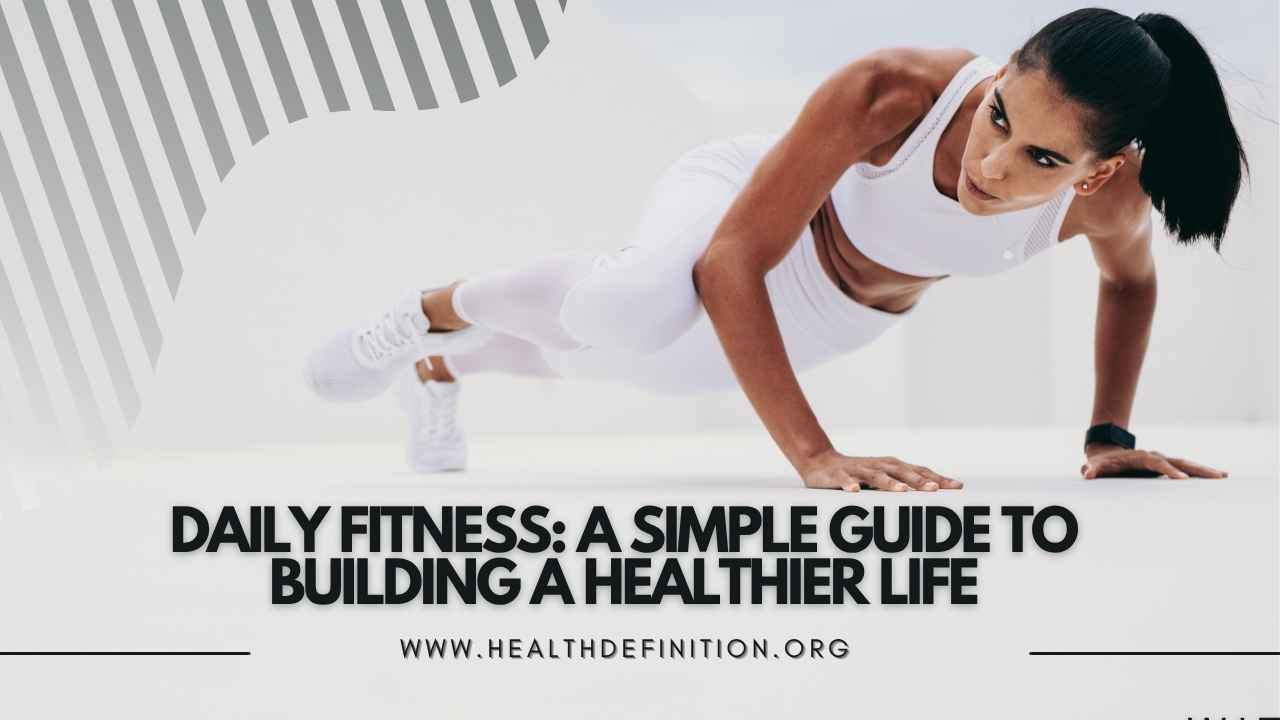
In today’s fast-paced world, maintaining daily fitness can feel like a daunting task. But the truth is, building a fitness routine doesn’t have to mean spending hours in the gym or following complicated meal plans. It’s about creating consistent, manageable habits that improve your overall well-being—physically, mentally, and emotionally.
This article explores the essentials of daily fitness, why it matters, and how you can get started with a routine that suits your lifestyle.
Why Daily Fitness Matters
Daily fitness isn’t just about losing weight or building muscle. It’s about creating a foundation for a healthier, longer, and more fulfilling life. Here are some compelling reasons to make daily movement part of your routine:
1. Boosts Energy and Mood
Physical activity stimulates the production of endorphins—your brain’s feel-good chemicals. Even a short walk or stretching session can reduce stress, ease anxiety, and improve your overall mood.
2. Improves Heart Health
Regular exercise strengthens the heart muscle, lowers blood pressure, improves cholesterol levels, and helps prevent cardiovascular diseases.
3. Enhances Mental Clarity
Fitness has direct ties to better cognitive function. Whether it’s a brisk morning jog or a calming yoga session, physical activity can improve focus, memory, and productivity.
Daily fitness is the art of weaving movement into your everyday life. It’s not about intense workouts or strict routines—it’s about creating small, consistent habits that fuel your body, clear your mind, and elevate your energy. From morning stretches to evening walks, daily fitness is a sustainable path to long-term health, no matter your schedule or fitness level.

4. Supports Weight Management
Consistent daily movement helps regulate metabolism, burns calories, and contributes to maintaining a healthy body composition.
5. Builds Discipline and Routine
The habit of showing up daily—even for 20 minutes—builds mental toughness and self-discipline, which can benefit every area of your life.
How to Start a Daily Fitness Routine
Starting a fitness journey doesn’t require a gym membership or fancy gear. It simply requires consistency and a plan that works for you. Here’s how to get started:
1. Set Clear, Realistic Goals
Are you aiming to get stronger? Lose weight? Improve mental clarity? Defining your goals will help you choose the right activities and stay motivated.
2. Start Small
You don’t need to work out for an hour a day. Begin with 15–30 minutes of movement that gets your heart rate up. Walking, dancing, or even active chores count.
3. Choose Activities You Enjoy
The best workout is the one you’ll stick to. Enjoy swimming? Try a few laps daily. Like music? Turn on a playlist and dance for 20 minutes.
4. Create a Schedule
Consistency is key. Set a specific time each day for your workout. Morning, lunch break, or evening—whatever fits your routine best.
5. Track Your Progress
Use a journal or fitness app to track your workouts. Seeing your consistency grow is incredibly motivating.
Daily fitness is more than a workout routine—it’s a lifestyle commitment to better health, sharper focus, and sustained energy. By incorporating small, consistent movements into your day, you can transform your body and mind without drastic changes or gym memberships.
Whether it’s a brisk walk, home yoga, or stretching between meetings, daily fitness empowers you to take control of your well-being—one step at a time.
Simple Daily Fitness Ideas for Busy People
Not everyone has an hour to spare, but that doesn’t mean you can’t be active. Here are simple, effective ways to move your body every day:
-
10-Minute Morning Stretch: Start your day with basic stretches to loosen up your body and improve circulation.
-
Desk Exercises: Do calf raises, shoulder rolls, or seated leg lifts during work hours.
-
Lunchtime Walks: Use part of your break to walk outside. Sunshine and fresh air provide an added mental health boost.
-
Home Workouts: YouTube has thousands of free, guided workouts ranging from yoga to high-intensity interval training (HIIT).
-
Evening Wind-down Yoga: Great for improving flexibility and relieving stress before bedtime.

Nutrition and Daily Fitness: A Powerful Combo
Physical activity alone isn’t enough. Pairing your fitness routine with smart nutrition choices helps fuel your body and accelerate results. Here are a few quick tips:
-
Hydrate Well: Drink plenty of water throughout the day, especially before and after workouts.
-
Eat Whole Foods: Focus on vegetables, fruits, lean proteins, whole grains, and healthy fats.
-
Avoid Processed Junk: Limit sugar, soda, and packaged foods that lack nutrients.
-
Don’t Skip Meals: Balanced meals keep your metabolism steady and energy levels high.
How to Stay Motivated
Motivation can fluctuate, but habits keep you going. Here’s how to keep your fitness routine from fading out:
-
Set Milestones: Celebrate progress, like completing your first week or hitting a 30-day streak.
-
Find a Fitness Buddy: Accountability partners make working out more fun and consistent.
-
Switch Things Up: Try new activities to keep it exciting, such as cycling, hiking, boxing, or Pilates.
-
Remind Yourself Why You Started: Write down your “why” and revisit it when motivation dips.
Listen to Your Body
Daily fitness should enhance your life, not exhaust you. It’s essential to listen to your body’s signals:
-
Take Rest Days When Needed: Rest is part of progress. Overtraining can lead to injury or burnout.
-
Prioritize Sleep: Recovery happens when you sleep. Aim for 7–9 hours of quality rest.
-
Respect Your Limits: Push yourself, but don’t ignore pain or discomfort that feels off.
Final Thoughts
Daily fitness is more than just a workout—it’s a lifestyle choice. It doesn’t require perfection. What matters most is showing up consistently, even when it’s just for 10 minutes.
Your future self will thank you for every small effort made today. Remember, health isn’t a destination—it’s a journey. And it starts with one simple choice to move your body a little each day.
So, make a non-negotiable part of your daily routine, whether it’s a walk around the block, a short yoga flow, or a few bodyweight exercises at home.

FAQs About Daily Fitness
What is the best time of day to work out?
There’s no universal “best” time—it depends on your schedule and energy levels. Morning workouts may boost metabolism and productivity, while evening sessions can help relieve stress. The key is consistency. Choose a time that works best for you and stick with it.
How long should a daily workout be?
Even 20–30 minutes of moderate exercise daily can provide significant health benefits. Beginners can start with shorter sessions and gradually increase time and intensity as endurance builds.
Can I work out every day, or should I take rest days?
Yes, you can exercise daily, but vary the intensity. Include light activity like stretching or walking on rest days. It’s important to give your muscles time to recover, especially after intense workouts like weightlifting or HIIT.
Do I need to join a gym to stay fit daily?
Not at all! Daily fitness can be achieved through home workouts, outdoor activities, or even bodyweight exercises. Apps, YouTube videos, and online programs offer plenty of free resources for staying active without a gym.
What if I don’t have time for a full workout?
Short workouts can still be effective. Try “exercise snacks”—5 to 10-minute sessions spread throughout the day. Something is always better than nothing, and consistency matters more than duration.
Is walking considered a daily workout?
Yes! Brisk walking improves cardiovascular health, burns calories, reduces stress, and is gentle on the joints. Aim for at least 30 minutes a day for noticeable benefits.
How do I stay motivated to work out every day?
Set clear goals, track your progress, and choose activities you enjoy. Having a workout buddy, listening to music, or rewarding yourself for consistency can also help keep you motivated.
What should I eat before and after a workout?
-
Before: A light meal or snack with carbs and protein (e.g., a banana with peanut butter or oatmeal).
-
After: Focus on replenishing energy with protein and complex carbs (e.g., grilled chicken with brown rice or a protein smoothie).
Can daily exercise help with weight loss?
Yes, especially when combined with a healthy diet. Daily movement boosts metabolism and helps burn calories, supporting fat loss over time. However, diet plays a crucial role in weight management.
What are the best exercises for beginners?
Start with low-impact activities like:
-
Walking
-
Yoga
-
Bodyweight exercises (squats, push-ups, lunges)
-
Cycling
-
Swimming
As your fitness improves, you can gradually introduce strength training or interval workouts.
Bullet Points on Daily Fitness
-
Daily fitness improves mental and physical health through consistent movement.
-
Short workouts (15–30 minutes) can be just as effective as longer sessions.
-
Regular exercise boosts energy, mood, and cognitive function.
-
Consistency is more important than intensity—start small and build gradually.
-
Walking, stretching, and home workouts are great for busy schedules.
-
Fitness can be done anywhere—no gym required.
-
Mix up your routine to stay motivated and avoid plateaus.
-
Hydration and proper nutrition enhance fitness results.
-
Daily activity helps regulate weight, improves heart health, and supports better sleep.
-
Rest days and sleep are essential for recovery and long-term progress.
-
Tracking progress (apps, journals, photos) can boost motivation.
-
Fitness is a lifelong habit, not a short-term fix—focus on sustainability.






